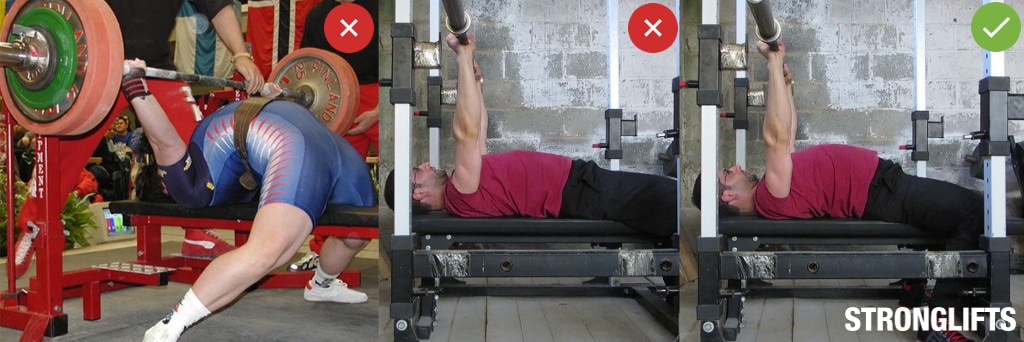Bench presses are such an exercise in which details in the execution have major consequences for performance and safety. Now take the position of the back. It makes quite a difference whether you lie flat on the bench or with a small concave or arch (‘arch’) in the back. Which execution is better?
STABLE BASE
You don’t just do a bench press. Many people go wrong before they have even started the exercise. They casually lie back on the bench as if they were going to take a sunbath. The result? Struggling with the bar and sub-optimal performance.
An optimal attempt at the bench press requires a stable base and (muscle) tension from head to toe. You create this tension by positioning your feet slightly back and planting your heels firmly in the ground. In addition, you should tighten your glutes and – yes – arch your back a bit. That is something that most reputable coaches agree on by now.
WHAT EXACTLY IS ‘ARCHING’?
To arch your back means to press your shoulder blades together and then down. This automatically creates a small hollow in the lower part of your back.
We say emphatically ‘small’, as you should not exaggerate that arching. It is crucial that your buttocks and shoulder blades remain in contact with the bench throughout the exercise. So don’t make it a glorified glute bridge. In fact, arching is nothing more than maintaining the natural curve in your lower back throughout the exercise.
 Make sure you have an ‘arch’ in your back, but don’t overdo it as in the photo on the left. (Stronglifts)
Make sure you have an ‘arch’ in your back, but don’t overdo it as in the photo on the left. (Stronglifts)WHAT ARE THE ADVANTAGES?
The posture we described offers a number of great advantages during the bench press:
- You lie more stable on the couch and can better maintain tension over your entire body. This way you can perform the exercise more controlled and therefore safer. In addition, you put your stabilizing muscles to work;
- You place your shoulders in a more comfortable position, which prevents shoulder injuries. The shoulder is the most unstable and therefore most vulnerable joint in our body;
- In this position, your shoulders will not roll forward. That means your pecs will be activated more and your front shoulders less, especially in the last part of the movement when the bar is approaching your chest. In short, you make it more of a chest exercise, so that you can also exert more force (after all, the chest muscles are stronger than the front shoulder heads);
- The concave makes your chest a little higher, which slightly reduces the range of motion. After all, you shorten the distance that you have to cover with the barbell towards the chest, and back again. This also allows you to lift slightly heavier than with a flat back, which is especially interesting for powerlifters.
As bodybuilding coach Lee Hayward sums it all up:
(…) This proper set up targets the major muscles that you want to work, puts you in a stronger position to bench, and it reduces your risk of a shoulder / rotator cuff injury.
ARE THERE ALSO DISADVANTAGES?
A few might refer to arching as a form of cheating, as it narrows the range of motion a bit. Now it is true that in principle you should aim for the largest possible range of motion. However, not if this is at the expense of safety and/or effective training of the target muscle. In the flat bench press, both are compromised. At least we don’t assume that you do the bench press to primarily train your front shoulders.